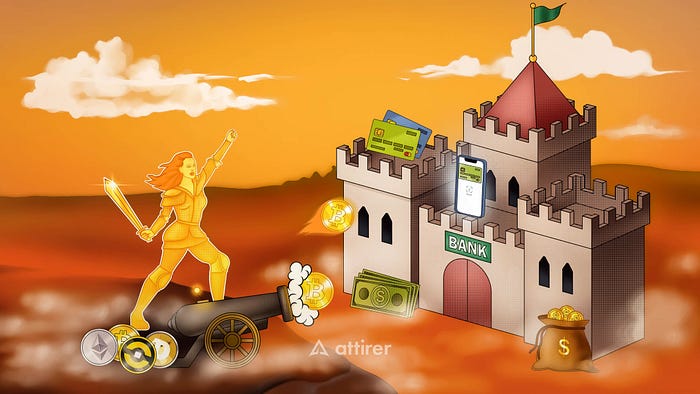Since the Bitcoin launch in 2009, Blockchain and Traditional Finance (TradFi) hardliners have been clashing over why and how one system will outlive, replace or replace the other. But as so often, conflict rarely results in victory for either side. Whether armed or otherwise, conflict almost always results in significant technological advancements and forces people to think outside the box.
If history has told us one thing, revolutions rarely succeed. Revolution means rapid change, usually by force, and intends to replace one system with another. However, humans are creatures of habit, and behavioral change can't be forced upon them. Pressure might lead to submission, but not necessarily to acceptance and almost certainly to resistance.
What if, instead of a revolution, we opt for an evolution? Isn't constant evolution what made the world we live in today? Hasn't evolution always outlasted revolutionist concepts? So why would it be any different this time?
Spoiler alert; It won't!
Over the past years, the rivalry between Blockchain and TradFi has resulted in many innovative projects, often using the best of both worlds. Some of the most traditionalist financial institutions work on blockchain projects. Regulators realize that blockchain technology is not all bad, and crypto millionaires still spend fiat money.
In this article, we will discuss concepts of how such an evolution might benefit everyone and what the coexistence of Web3 and TradFi could look like in a not too far away future.
Key Takeaways
- It is not a question of Blockchain vs. Finance, but how new technology can bring an existing system to the next level.
- The revolutionary aspect of blockchain is slowly fading as technology matures.
- Financial institutions and regulators are increasingly involved in blockchain projects.
- There are clear benefits for the financial industry, but adoption remains slow due to lacking legal frameworks.
- The solution for success is not in the cryptocurrencies but the underlying blockchain technology.
The Birth of Crypto

After the global financial crisis in 2009, the website bitcoin.org published a whitepaper "Bitcoin: A Peer-to-Peer Electronic Cash System" by Satoshi Nakamoto. The paper outlines the concept of P2P money transfers. Although nothing new, similar ideas were deemed too complex for implementation. Sharing a seemingly identical fate, the Nakamoto paper initially received little attention.
But it didn't take long until the paper started spreading. Surprisingly not along with economists and finance circles but within the IT community.
Bitcoin, worth cents on the dollar, was used to pay for transactions between a small but ever-growing circle of developers, enthusiasts, and alternative thinkers. Pizzas change hands for thousands of coins, and it is not until a few years later that mainstream media picks up on this phenomenon.
After years of slumber, the price starts to multiply. $100, $200, $1000… Until the price and performance become so big that it catches the interest of traditional finance. Praised by purists as a replacement for traditional fiat money, banks and regulators are quickly going defensive and are not shy to denounce Bitcoin publicly as a niche product doomed to fail. And in 2017, they seem to get confirmation.
Bitcoin prices tumble 70% off-peak and mark the beginning of a bear market that would last until December 2020, the first crypto-winter.
But while the first crypto-winter might have taken the spotlight somewhat off Bitcoin and other newly emerged cryptocurrencies, the marks these alternative concepts of money left were too great to ignore. Despite the crypto-winter, new blockchain projects appear across many industries, and a race for adoption begins.
Traditional Finance Explores Blockchain
Due to their size, systemic relevance, and high regulatory requirements, financial institutions generally slowly embrace new technology. This trend was visible with the rise of the Internet in the early 2000s and is undoubtedly no different regarding cryptocurrencies and blockchain.
But while in 2017, most financial institutions still openly opposed the idea of crypto as a replacement for Fiat currencies, some started exploring this new technology, often in total secrecy. Too significant is the risk of being associated with the "enemy." Call it a defensive move to avoid getting caught off guard, foresight, or simply greed and fear of missing out.
Whatever it was, it clearly showed that blockchain technology was a force to be reckoned with.
I deliberately chose the term "blockchain" over crypto here since the technology behind the cryptocurrencies caught the center of banks' interest.
Financial institutions suffered a considerable loss of trust during the financial crisis in 2008. To people, the blockchains' promise of security, immutability, privacy, and transparency must have seemed like a beacon of hope to restore the shattered confidence in the system.
Since then, we have seen several projects launched by financial institutions, regulators, and tech companies aiming to challenge existing structures. Some are more fruitful than others, but in general, the sentiment seems to gradually shift since the first appearance of Bitcoin.
Easier said than done.
As promising as the concept of blockchain sounds. Traditional financial institutions continue to face significant hurdles before they can openly embrace this new technology.
Legacy Issues
Financial institutions and their regulatory frameworks were established centuries ago and have been part of constant evolution and compromise. Many of their operating models only started to embrace the full potential of internet and cloud computing post-2008. Introducing yet another radical change in how data is transacted, managed, and stored will require time. Moreover, changing legacy IT systems is highly expensive, and not all players can afford it.
Regulatory Issues
Even if a financial institution is ready to make a change and adopt blockchain technology, most regulatory frameworks won't permit it at this stage. Most blockchain projects' decentralized and permissionless nature creates great confusion and security concerns among banks and regulators alike. Only now do we see the first attempts to build a regulatory framework for blockchain and crypto-assets. However, these regulations are still fragmented and far from globally aligned. For multinational companies, this raises the barrier of entry significantly.
Risk Factors
Reports of fraud and scams show that security is still not under control. Daily headlines from the crypto world about exploits on CEX and DEX, failing (stablecoin) protocols, and illicit transactions using cryptocurrencies fuel the fear of getting burnt when exposed to crypto and blockchain.
Financial institutions, by definition, are risk-averse entities and will not roll out large-scale changes as long as new technology is not as safe, thoroughly tested, and lacks legal tools to confront such issues. Too present are the memories of the 2008 crisis, and no one in the industry wants to be the first to make negative headlines.
Scalability, Speed & Security
The unwritten rule of speed vs. scalability vs. security still plays a major role in hampering the widespread adoption of blockchain technology. With the emergence of different layers, forks, and side-chains attempting to tackle the issue, there is still no easy solution to the problem. Although the existing setup of financial services faces similar scalability problems, the current system is still good enough to cope with the demands. Hence there is a certain reluctance to change a working concept, although its flaws are apparent.
Fear of losing control
With a few prominent behemoth players ruling the current financial markets, decentralizing finance through blockchain would threaten their existence or lead to a partial loss of control over a very profitable market.
Cost
Despite being done mainly through community projects and open-source protocols, establishing a functioning blockchain or developing infrastructure on an existing chain can quickly become expensive. Moreover, rising inflation rates and the risk of an impending economic recession force many institutions to cut costs and reduce their R&D budgets. Although most likely temporary, this inevitably slows the adoption of new technology.
Should traditional finance continue experimenting with Blockchain Technology if it's all bad?
The short answer is yes — The theoretical benefits of blockchain technology, whether socially or financially, are too great to ignore.
Let's explore blockchain's benefits to financial markets and look at current projects to see how Web3 can help a five-century-old industry get its services into a new phase of existence.
Money Transfers
How money transfers are conducted in our global economy is slow, expensive, and requires a great deal of administration. For example, the SWIFT system that enables international money transfers settles with a T+2 standard. In today's fast-moving economy, this brings some severe limitations. Ever-increasing KYC and AML requirements for transfers require a lot of administration and record-keeping, often in paper or rudimentary server solutions, which puts the data at risk.
Reducing the number of steps and stops for money transfers is cutting costs. Fewer middlemen also mean more privacy as the data is shared with fewer parties. And lastly, the blockchain's infinite ledger can help reduce malicious transactions and help to track the flow of assets.
Smart Contracts
Smart contracts, in their simplest form, refer to lines of code that allow a transaction to happen only after a predefined set of rules are fulfilled by all involved parties. With smart contracts, counterparty risk is reduced, and (manual) processing times are shortened. This technology can significantly increase efficiency and reduce costs for lenders and other financial institutions.
For example, securities traded via smart contracts would significantly shorten settlement times, improve reporting quality and reduce counterparty risk.
Tokenization of Assets
Tokenizing assets via blockchain can help facilitate how assets are traded, how many intermediaries are required, and how values are stored. Large assets can be fractionalized and made available to a broader group of investors.
With smart contracts, investors can assess investment risk better before buying an asset, thus helping protect investors and markets. Transferring tokenized assets simplifies the record-keeping and allows regulators to follow flows in real-time.
Data Reconciliation
The finance industry relies heavily on information, whether it is transactional history, know-your-customer (KYC) records, or financial data. Today this data is often stored in proprietary databases. These databases provide a single point of failure that third parties can exploit. In addition, once delivered, the initial owner can usually no longer control this data. And while regulations such as the GDPR offer certain protection, the single-point risk remains.
As Deloitte points out in one of their reports:
"…companies independently maintain actuality of data in their systems, so in a business transaction numerous business processes flow slowly and inefficiently due to the need of transacting parties to reach an agreement on the congruity of records."

With the use of blockchain, data can be streamlined and maintained in real-time while at the same time being protected through encryption.
Better data reconciliation would allow banks to provide a more targeted offering and remove redundant operating cycles.
Financial Inclusion
Some reports show that up to 1.7bn people have no access to financial services and are thus classified as "the unbanked." Through blockchain, secure channels can be established, providing banking services to people without relying on the physical presence of either the bank or the client. Banks can provide essential services at a low cost. All that is required is an internet connection.
Digital identities would allow customers to build a track record that can be carried with them even if they move locations. Think of an expat that would like to maintain a bank account in his country of origin.
Reduced Fraud
Being an immutable ledger, a blockchain can help to reduce fraudulent transactions while at the same time helping to protect information. For example, a blockchain-based credit score could allow banks to reduce credit risk while simultaneously offering customers better conditions. In addition, bank transfers on a blockchain can be traced easily, and securities can be traded instantly without relying on manual clearing processes. Blockchain-based shareholder voting facilitates the process, adds transparency, and provides results in real-time.
Central Bank Digital Currencies (CBDC)
Think of a cryptocurrency issued by a central bank, such as a digital dollar. Although Fiat money has made its way into the digital age with e-banking, online payment providers, e-lending, and online trading, the actual underlying monetary system still follows the same rules and concepts as in the pre-internet era.
CBDCs could offer a way to maintain the way and feel we use money today while simultaneously improving some of the shortcomings. A digital currency would allow central banks to exercise better control of the money supply and understand the flows within an economy.
It is thus not surprising that many governments and think tanks openly discuss CBDCs.
What projects are financial institutions, regulators, and central banks working on?
After discussing some theoretical aspects of how blockchain technology can help traditional finance, let's look at some of the most notable projects.
The website CBDC Tracker provides an exciting and real-time overview of what digital currency projects countries are currently working on.

Many banks actively acquire blockchain-related companies or partner with them to develop solutions on their behalf;
- Goldman Sachs looking to acquire distressed Celsius.

- JP Morgan builds its own Crypto and Blockchain division.

- The European Central Bank is actively thinking about a digital Euro.

- The US is seeking to regulate Stablecoins.

- VISA is offering crypto exposure.
https://usa.visa.com/solutions/crypto.html
These developments are just the tip of the iceberg, but they clearly show the importance of the topic and how much interest the financial markets have in Web3.
What does the future hold for the crypto Revolution?
If we learned one thing from the past, then the future is rarely what we expect it to be. However, there is an apparent convergence between the blockchain and the financial industry. Maybe we don't need to uproot our traditional ways of interacting with money. But the current system has some evident shortcomings and could profit from an upgrade.
Having started as a revolutionary idea, blockchain technology is slowly maturing with ever better use cases, sending a wake-up call throughout many industries. Established financial institutions and regulators gradually see the benefits of this new technology and incorporate it into their thinking process.
Increased security, more efficient processes, and transparency could surely help bring the banking industry to the next level. But we must not forget that many of these companies carry a high systemic relevance in our everyday lives. So we might want to be careful how much trust we put into Web3 projects and ensure that we thoroughly understand the benefits and, maybe even more importantly, the risks.
Thus, all stakeholders must work closely together to benefit the greater good. Maybe this is one of the key traits of the blockchain space. People are enthusiastic, creative, and open to collaborating to solve major issues and improve how we go about our everyday lives.
Will everything be blockchain? Maybe not, but if done right, we could lay a foundation upon which we can ensure a stable future for the financial industry. A future built on trust, mutual benefit, and understanding.
But before we get there, we need fundamental changes in how we think about traditional finance, blockchain, crypto, and regulations.
The Revolution is dead; long live the Evolution!
A word from the Author
Thanks for reading! If you liked the article, subscribe for more stories at Attirer Web3 Wire!
I hope you had a good read on this independent analysis by Inside the Block for the Yellow Network. Feel free to contact me or kickstart a conversation in the comments!
Disclaimer: Any information in this article is based on my personal experience, out of personal interest, and to my best knowledge and ability. This article has no promotional purpose, does not represent investment advice, and any names, brands, and tickers mentioned in this article are for illustrative purposes only. Use any of the associated links with care and at your own risk. Always do your own research.
Discover Web3 and Dive into DeFi with Yellow Network!
Yellow powered by Openware is developing an unprecedented worldwide cross-chain P2P liquidity aggregator Yellow Network, designed to unite the crypto industry and provide global remittance services actually helpful to people.
Are you a crypto developer? Check out the OpenDAX v4 white-label cryptocurrency exchange software stack on GitHub, designed to launch market-ready crypto exchange brokerage platforms with a built-in liquidity stream.
Join the Yellow Community and dive into the most product-oriented crypto project of this decade:
- Follow Yellow Twitter
- Join Yellow Telegram
- Check out Yellow Discord
Stay tuned as Yellow Network unveils the development, technology, developer tools, crypto brokerage nodes software, and community liquidity mining!
















